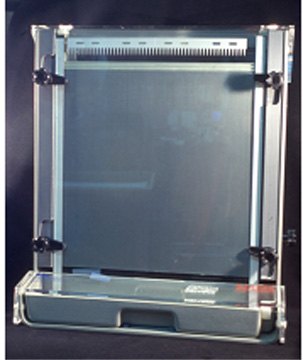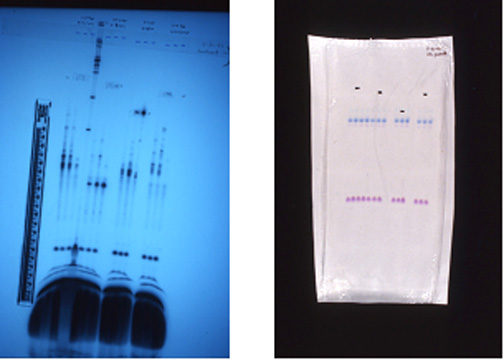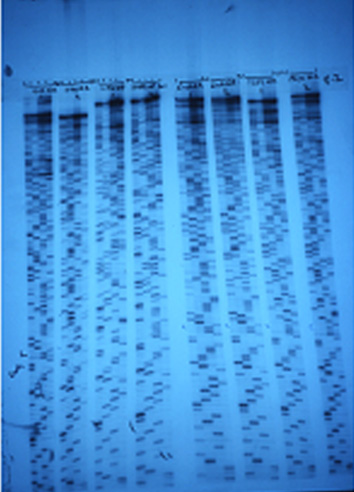Closing in on a Killer: Scientists Unlock Clues to the Spanish Influenza Virus
1996: Taking a Second Look at a Lung Sample
In 1996, Jeffrey Taubenberger of the Armed Forces Institute of Pathology (AFIP) began to isolate the 1918 influenza genome from the archived lung tissue of Army Private Roscoe Vaughan, sequencing the complete genome by 2005. The H1N1 influenza pandemic of 2009 was caused by a similar virus.
Based on the scientific and historical data from the 1918 pandemic, the 2009 vaccination campaign was focused on young adults rather than the more traditional risk groups of infants and the elderly. Insights into the structure of the 1918 virus continue to inform the development of new 'universal flu' vaccines.
 Jeffrey Taubenberger and Ann Reid researching the 1918 Spanish flu. (MIS 377212)
Jeffrey Taubenberger and Ann Reid researching the 1918 Spanish flu. (MIS 377212)
Among the 2.5 million pathological specimens maintained at the AFIP were more than 70 lung specimens related to the 1918 influenza pandemic. Scientists searched the medical records to select cases most likely to contain the virus; patients who had died within a week and showed signs of viral pneumonia. Of the six cases that remained, only the case of World War I Army Private Roscoe Vaughan still had genetic material from the influenza virus.
With the genetic material found in the tissue sample from Vaughan, scientists hoped to isolate the genetic sequence of the virus using the Polymerase Chain Reaction (PCR) process. If fragments of the 1918 influenza could be replicated, its genetic code could be compared to other influenza strains.
Step 1: Extraction
The first step of the process was to extract the genetic material from a thin slice of a paraffin embedded sample from Vaughan's lungs. First the wax and then the lung tissue were dissolved, leaving only strands of genetic material from the serviceman, the influenza virus, and whatever additional microorganisms were in the sample.
 Micro slide and paraffin embedded sample of lung tissue from World War I Army Private Roscoe Vaughan, ca. 1918. AFIP 1140. Courtesy Department of Cellular Pathology, AFIP.
Micro slide and paraffin embedded sample of lung tissue from World War I Army Private Roscoe Vaughan, ca. 1918. AFIP 1140. Courtesy Department of Cellular Pathology, AFIP.
Step 2: Isolation
Once the strands of genetic material were extracted, samples were replicated using a PCR machine. A "primer," a short strand of genetic material, was used to hunt for fragments of the influenza virus. Because the structure of the virus was unknown, a different pair of primers was used in each test tube.
 A rack of Eppendorf tubes to be used in a PCR machine. (M-722 10193)
A rack of Eppendorf tubes to be used in a PCR machine. (M-722 10193)
Step 3: Selection
Fragments were run through the sequencing gel, which acts like a funnel to separate the specific viral fragments according to length. A radioactive marker was used to find the large fragments on the gel, which were cut out. Because there was only a small amount of genetic material, the fragments were copied using the PCR machine.
 Sequencing Gel Electrophoresis System, Model S-2. Bethesda Research Laboratories Life Technologies, Inc. manufactured this device, ca. 1990. (M-722 10194)
Sequencing Gel Electrophoresis System, Model S-2. Bethesda Research Laboratories Life Technologies, Inc. manufactured this device, ca. 1990. (M-722 10194)
 Sequencing gel containing genetic fragments and the exposed X-ray plate used to locate the fragments for further analysis. (M-722 10195)
Sequencing gel containing genetic fragments and the exposed X-ray plate used to locate the fragments for further analysis. (M-722 10195)
Step 4: Analysis
The fragment of the influenza virus was then analyzed in order to determine the underlying genetic structure. A computer was used to compare the genetic sequence to other strains of influenza.
A computer-generated chart compared the 1918 Influenza virus ("1918 case 1") to other influenza viruses. Viruses are named according to the location of the outbreak followed by the year. Related viruses are close together on the chart.
 Exposed X-ray showing genetic sequence of the influenza virus. (M-722 10196)
Exposed X-ray showing genetic sequence of the influenza virus. (M-722 10196)
Continue to find additional reading resources.



